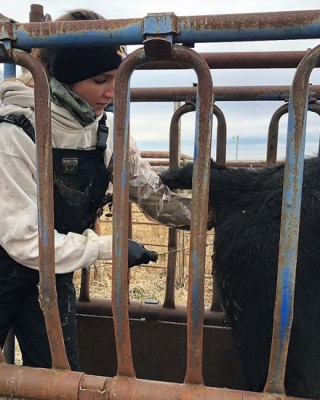Benefits of Estrus Synchronization and Artificial Insemination

Benefits of Estrus Synchronization and Artificial Insemination
Mark Z. Johnson, Oklahoma State University Extension Beef Cattle Breeding Specialist
Regardless of when your calving season occurs, manipulating the reproductive process of your cow herd can result in shorter breeding and calving seasons. Accordingly, more calves born earlier in the calving season result in an older, heavier, more uniform calf crop when you wean. Shortened calving seasons permit improvements in herd health and management such as timing of vaccinations and practices that add to calf value with less labor requirements (or at the very least concentrating labor efforts into a shorter time frame). Cows that are closer to the same stage of gestation can also be fed and grouped accordingly which facilitates a higher level of management.
Estrus synchronization can be used for natural mating or breeding by Artificial Insemination (AI). Synchronization protocols permit us to concentrate the labor needed for heat detection to a few days, and in some cases eliminate the need for heat detection when cows can be bred on a timed basis. Choosing an estrous synchronization protocol which can be used with AI or natural mating can be difficult as a number of synchronization methods are available. Traditional protocols are designed to mimic or control the corpus luteum on the ovary. Newer protocols have been designed to control ovulation and/or the follicular waves that occur on the ovary during the 21-day estrous cycle. Estrus synchronization systems vary in cost, labor required, and effectiveness. Management decisions regarding synchronization should be based on answers to the following questions:
1.) Do you have adequate labor and facilities to successfully implement the management practices involved? Most synchronization protocols will require at least two trips through the chute, plus at least one more if breeding by AI. Heat detection will require labor for several hours, twice a day to observe standing heats. Labor will be required to sort cows.
2.) Do you have an AI technician available for the duration of time you will be AI breeding cows?
3.) Cost of synchronization protocols can vary significantly. Is the cost justified? Whatever method you determine best fits your operation, be sure to use the correct synchronization product at the recommended time and follow Beef Quality Assurance practices when administering the product.
4.) Have you identified an AI sire(s) offering the genetic potential to increase your profit potential relative to your intended marketing endpoint or use of calves sired?
Use of AI permits us to get more cows bred to genetically superior sires for traits of economic importance to our operation's production and marketing goals. Synchronization at the onset of breeding season, results in more cows having heats in the first 18 - 25 days of breeding season. Female's return heats will remain synchronized to a degree, which gives a second chance to AI each female in the early part of breeding season. Without any synchronization, herd managers are faced with a 21 days of continual estrus detection and typically only one opportunity for AI in most females.
Bottom Line: estrus synchronization can be an important management tool to get cows settled as early in the breeding season as possible and get cows bred to bulls with highest possible genetic value. A defined breeding season is important to permit meaningful record keeping, timely management and profit potential. Maintaining a 60-to-75-day breeding and calving season can be one of the most important management tools for cow calf producers.
Mark Johnson, OSU Extension beef cattle breeding specialist, explains the process of heat synchronization in cow herds on SunUp TV from April 16, 2022. https://www.youtube.com/watch?v=2GFR5baoRls&list=PLglOSpV-Tcac6-pVMv0BEAk78_7tJCuap&index=52
Photo from the University of Missouri Extension
Upcoming Events
WEBINAR - Automated Milking Systems Efficiency: Balancing Focus on Individual Cows and System Optimization
May 8, 2024
Please join Cornell the SWNY team and MSU Extension for our talk with Dr. Pablo Silva Boloña on improving efficiency of Automated milking systems by focusing on milking settings for individual and group success.
Broiler Field Day at Sunny Cove Farm
June 6, 2024
Alfred Station, NY
Join us for a field day to explore broiler production, processing, and finances. Meghan Snyder of Sunny Cove Farm will be our host. She raises small batches of organic broilers, processing them on-farm under the 1,000 bird exemption.
Stockmanship and Stewardship 2024
October 25, 2024
Hamburg, NY
Save the date!! The event is one of 4 across the US and is a two-day educational experience featuring low-stress cattle handling demonstrations, Beef Quality Assurance educational sessions, facility design sessions, and industry updates.
Announcements
No announcements at this time.





